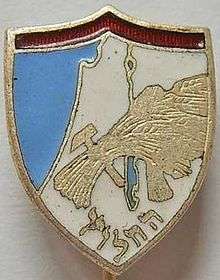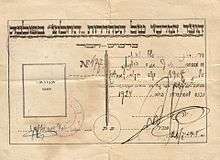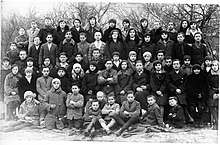HeHalutz
HeHalutz or HeChalutz (Hebrew: הֶחָלוּץ, lit. The Pioneer) was a Jewish youth movement that trained young people for agricultural settlement in the Land of Israel. It became an umbrella organization of the pioneering Zionist youth movements.


History
Before WWI (1905-1914)
HeHalutz was founded by Eliezer Joffe in America in 1905, and about the same time in Russia.[1]
First World War (1914-1918)
During World War I, HeHalutz branches opened across Europe (including Russia), America and Canada. Leaders of the organization included Yitzhak Ben-Zvi (later the second president of the State of Israel), and David Ben-Gurion (later the first Prime Minister of Israel) in America, and Joseph Trumpeldor in Russia.
Ben-Gurion was living in Jerusalem at the start of the First World War, where he and Ben Zvi recruited forty Jews into a Jewish militia to assist the Ottoman army. Despite this, he was deported to Egypt in March 1915. From there he made his way to the United States, where he remained for three years. On his arrival, he and Ben Zvi went on a tour of 35 cities in an attempt to raise a Hechalutz "pioneer army" of 10,000 men to fight on Turkey's side.[2] After the Balfour Declaration of November 1917, the situation changed dramatically and Ben-Gurion, with the interest of Zionism in mind, switched sides and joined the newly formed Jewish Legion of the British Army, leaving to fight the Turks in Palestine.
Interbellum (1918-1939)

At its peak, between 1930 and 1935, HeHalutz operated in 25 countries throughout Europe, North Africa, the Middle East, and Northern South America.
North America
In 1932-1934, Golda Meir, later the prime minister of Israel, was the secretary of the women's chapter of HeHalutz in the United States.[3]
In 1932, the organization established headquarters in New York and twenty branches in cities and towns throughout the United States and Canada. Farms were then established to train members for agricultural work in Palestine. Such farms operated in Cream Ridge and Hightstown, New Jersey; Poughkeepsie, New York; Smithville, Ontario; and Colton, California.[4]
Germany
In 1933, after Jews were expelled from the workforce in Nazi Germany, HeHalutz farms became the primary framework for vocational training and preparation for emigration.[5]
1939
By the eve of Second World War in 1939, HeHalutz numbered 100,000 members worldwide, with approximately 60,000 having already emigrated (aliyah) to Mandate Palestine, and with 16,000 members in training centers (hakhsharot) for the pioneering life in the Land of Israel.[6]
Second World War (1939-1945)
During the war and German occupation, Jews in some ghettos in Europe established Hechalutz units, as in Lithuania's Šiauliai Ghetto.[7]
After WWII
By the 1950s HeHalutz"... was absorbed by Hashomer Hatzair, which had always maintained a large degree of autonomy. Nominally, however, the He-Ḥalutz Organization of America still exists...."[8]
References
- Ritov, Israel; Slutsky, Yehuda (2007). "He-Ḥalutz". In Michael Berenbaum and Fred Skolnik (ed.). Encyclopaedia Judaica. 8 (2 ed.). Detroit: Macmillan Reference USA. pp. 756–761.
- Teveth, Shabtai (1985) Ben-Gurion and the Palestinian Arabs. From Peace to War. Oxford University Press. ISBN 0-19-503562-3. pp. 25, 26.
- Golda Meir
- Jewish Virtual Library: HeHalutz
- Hagit Lavsky, Before Catastrophe: The Distinctive Path of German Zionism
- Resistance in the Smaller Ghettos of Eastern Europe, United States Holocaust Memorial Museum
- "The Shavli Ghetto". Association of Lithuanian Jews in Israel. Archived from the original on 30 September 2013. Retrieved 27 April 2012.
- Jewish Virtual Library: HeHalutz
- This article incorporates text from the United States Holocaust Memorial Museum, and has been released under the GFDL.